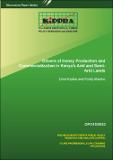| dc.description.abstract | Honey production and commercialization is a key source of income for households
in ASAL regions of Kenya where other forms of agriculture are limited due to
climatic conditions. Beekeeping is important for the economy; however, Kenya
has not utilized its production potential. Kenya is also a net importer of natural
honey. Beekeepers in ASALs face several challenges, including limited access
to credit, markets, and market information. This study examines the factors
influencing honey production and commercialization in ASAL regions of Kenya,
using data from the Kenya Integrated Budget Household Survey (KIBHS
2015/16). A total of 173 beekeeping households extracted across three ASAL
regions: non-arid, semi-arid, and arid were studied. The results show that the
type of beehive used, access to credit, and pesticide usage significantly influence
honey production. Beekeepers who use modern beehives produce more honey
than those who use traditional beehives. Access to credit allows beekeepers to
invest in necessary resources and infrastructure, which leads to higher honey
production. Pesticide usage is associated with lower honey production, as it can
kill bees directly, weaken them, and contaminate nectar and pollen. The results
also show that credit access and market access are significant factors in honey
commercialization, especially in the arid region. The study recommends that
policymakers tailor beekeeping support programs to the specific needs of each
region, support beekeepers in arid and semi-arid areas by providing them with
access to credit and promote sustainable beekeeping practices. | en |

